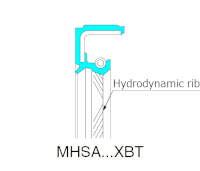What are bearing isolators?
First, wash your hands before handling the oil seal. This is because dirt on the sealing surface or oil in fingerprints can compromise the integrity of the seal, while small particles can cause wear and tear, damaging the sealing surface and leading to leaks.
Secondly, do not unpack the seal unless you are ready to install it. After opening, the seal face must be cleaned before installing it on the equipment to prevent contamination.
Finally, ensure that your equipment is clean. This is because dirty equipment can affect the effectiveness of the oil seal.
The lip is specially designed to ensure the oil seal works effectively with the different forces that arise during rotation. Many different designs and materials are used, so countless types of oil seals are available. These are chosen according to the application; pumps, gearboxes, wheels, and many other rotating applications where fluids need to be sealed. They are used in a variety of sectors, such as the chemical industry, manufacturing, wind turbines, automotive sector, food industry, and more. Oil seals are used in nearly all sectors.
Regular inspection and maintenance of oil seals are essential to identify signs of wear, damage, or leakage. Proper lubrication and adherence to recommended service intervals can help extend the lifespan of oil seals. When replacement is necessary, selecting the correct seal type and ensuring proper installation are critical to maintaining the integrity and performance of the equipment.
Rubber covered
Oil seals serve an important function in preventing lubricant leaks by closing in the spaces between the parts of the rotary shaft equipment. They also prevent dirt, dust, and other contaminants from clogging up the unit. Having them properly installed enables engines, pumps, and pipes to operate more efficiently.


